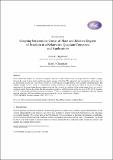| dc.contributor.author | Hagelstein, Peter L | |
| dc.contributor.author | Chaudhary, Irfan U. | |
| dc.date.accessioned | 2019-10-17T19:18:16Z | |
| dc.date.available | 2019-10-17T19:18:16Z | |
| dc.date.issued | 2017 | |
| dc.identifier.issn | 2227-3123 | |
| dc.identifier.uri | https://hdl.handle.net/1721.1/122617 | |
| dc.description.abstract | If we consider the nucleus as a relativistic composite, then we are able to derive from a many-particle Dirac model a coupling between the center of mass motion and internal nuclear degrees of freedom. This interaction can be rotated out in free space, but has the potential to give rise to new physics when two or more nuclei exchange phonons with a common vibrational mode. The simplest example of such a system is a homonuclear diatomic molecule in a frozen matrix, for which we are able to develop an expression for the second-order phonon-nuclear interaction that can result in a splitting of the nuclear energy levels as a result of excitation transfer between the nuclei. The phonon-nuclear coupling is an E1 interaction, so the low energy 6.237 keV E1 transition in ¹⁸¹Ta is special; this motivates an interest in molecular ¹⁸¹Ta₂ as a candidate for a Mössbauer experiment where the splitting might be observable. We also consider excitation transfer in the case of a macroscopic a Ta plate. Keywords: Down-conversion; Excitation transfer; Mössbauer effect; Phono-nuclear coupling | en_US |
| dc.language.iso | en | |
| dc.publisher | International Society of Condensed Matter Nuclear Scientists (ISCMNS) | en_US |
| dc.relation.isversionof | http://coldfusioncommunity.net/wp-content/uploads/2018/08/114_JCMNS-Vol24.pdf | en_US |
| dc.rights | Article is made available in accordance with the publisher's policy and may be subject to US copyright law. Please refer to the publisher's site for terms of use. | en_US |
| dc.source | Prof. Hagelstein | en_US |
| dc.title | Coupling between the center of mass and relative degrees of freedom in a relativistic quantum composite and applications | en_US |
| dc.type | Article | en_US |
| dc.identifier.citation | Hagelstein, Peter L. and Irfan U. Chaudhary. "Coupling between the Center of Mass and Relative Degrees
of Freedom in a Relativistic Quantum Composite and Applications." Journal of Condensed Matter Nuclear Science 24 (2017): 114-122 © 2017 ISCMNS | en_US |
| dc.contributor.department | Massachusetts Institute of Technology. Department of Electrical Engineering and Computer Science | en_US |
| dc.relation.journal | Journal of Condensed Matter Nuclear Science | en_US |
| dc.eprint.version | Final published version | en_US |
| dc.type.uri | http://purl.org/eprint/type/ConferencePaper | en_US |
| eprint.status | http://purl.org/eprint/status/NonPeerReviewed | en_US |
| dc.date.updated | 2019-10-10T14:22:20Z | |
| dspace.date.submission | 2019-10-10T14:22:21Z | |
| mit.journal.volume | 24 | en_US |
